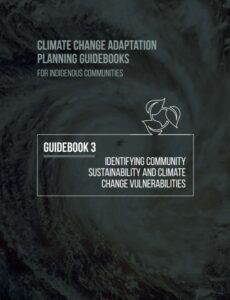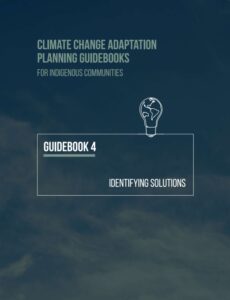The objective of the Indigenous Climate Change Adaptation Planning (ICCAP) Toolkit is to provide a suite of user-friendly tools, resources, and key considerations to support Indigenous individuals and communities interested in undertaking climate change adaptation planning. The intent is for the toolkit to be used by communities at all different stages of the adaptation planning process, including communities with little or no prior experience.
Pour la version française, suivez ce lien: Boite Á Outils De Planification De L’adaptation Aux Changements Climatiques Pour Les Communautés Autochtones
The ICCAP Toolkit was created by the Centre for Indigenous Environmental Resources (CIER) in partnership with Crown-Indigenous Relations and Northern Affairs Canada’s (CIRNAC) First Nations Adapt program. The ICCAP Toolkit consists of the following 4 key components:
- Indigenous Climate Change Adaptation Guidance Document
- Climate Change Adaptation Planning Guidebooks for Indigenous Communities
- Guidebook 1: Starting the Planning Process
- Guidebook 2: Climate Change Impacts in the Community
- Guidebook 3: Identifying Community Sustainability and Climate Change Vulnerabilities
- Guidebook 4: Identifying Solutions
- Guidebook 5: Taking Adaptive Action
- Guidebook 6: Monitoring Progress and Change
- Guidebook Annexes
- Two Indigenous Language Glossaries
- Indigenous Languages Glossary Workbook
1. Indigenous Climate Change Adaptation Guidance Document
The Indigenous Climate Change Adaptation Guidance Document has been developed to support Indigenous communities in identifying tools and resources, best practices, and key considerations that can be used for climate adaptation and resilient infrastructure planning related to the following climate risks or “impact areas”:
- Loss of Winter Roads;
- Wildfire;
- Inland Flooding; and
- Sea-Level Rise and Coastal Erosion.
2. Climate Change Adaptation Planning Guidebooks for Indigenous Communities
The Climate Change Adaptation Planning Guidebooks for Indigenous Communities consists of a series of six guidebooks. The guidebooks provide an overview of the six-step climate change adaptation planning process. The goal of the guidebooks is to provide a user-friendly and culturally appropriate climate change and adaptation resource to assist Indigenous communities with adaptation planning in order to avoid, minimize, or adapt to the impacts caused by climate change. The planning process outlined in the guidebooks allows for wide application, local adaptation, and ongoing modifications. Click on the photos below to download each of the six guidebooks and the appendices.
Guidebook 1: Starting the Planning Process
In Guidebook 1, you will learn more about climate change adaptation and why it is important. You will be provided with helpful information for assembling a team to help with the climate change adaptation planning process in your community. Guidebook 1 includes considerations for identifying a project coordinator, tips for meeting with leadership and assembling a working group to guide the project, information and suggestions for involving community members in the process, and examples from other communities that have done similar work.
Guidebook 2: Climate Change Impacts in the Community
In Guidebook 2, you will learn more about climate change as well as climate change adaptation (adjusting to existing climate change impacts) versus mitigation (reducing or preventing climate change impacts). Guidebook 2 includes several community stories that illustrate the effects climate change has had on Indigenous communities across Canada. Lastly, Guidebook 2 includes a series of activities to help you engage community members in order to identify local climate change impacts within your own community so that these can be incorporated into your adaptation plan.
Guidebook 3: Identifying Community Sustainability and Climate Change Vulnerabilities
In Guidebook 3, you will explore the concept of community sustainability versus community vulnerability to climate change. You will be guided through a series of brainstorm activities with different community members. The aim of the activities is to develop a community vision, consider ways in which your community is already sustainable, and consider the ways in which your community may be susceptible to climate change impacts. After working through these activities, you will develop different community climate change scenarios to explore what your community might look like if climate adaptations or interventions are implemented versus if they are not.
Guidebook 4: Identifying Solutions
In Guidebook 4, you will build on the influence diagrams and scenarios that you created in Guidebook 3 to identify and list climate change adaptation and coping solutions that are feasible for the community to implement. Once your list of adaptation solutions has been identified, you will work with community members to prioritize the potential solutions and determine which are most urgent or important to focus on implementing first. At the end of this guidebook, you should be ready to turn these prioritized solutions into actions.
Guidebook 5: Taking Adaptive Action
In Guidebook 5 you will focus on bringing your priorities into action to adapt to climate change. After working through the information and activities in Guidebooks 1-4 with the Working Group, leadership, Elders, youth, and other members of the community, you should have excellent information about the issues facing the community, including a shortlist of priority solutions focused on both climate change adaptation planning, as well as other community development and sustainability needs. Guidebook 5 includes suggestions for taking action to implement these ideas.
Guidebook 6: Monitoring Progress and Change
In Guidebooks 1-5, you assembled a climate change adaptation planning team, gathered background information, and determined adaptation priorities, before working with the community to develop and implement an action plan. Now, in Guidebook 6, you will focus on evaluating the success of your climate change adaptation plan and making any adjustments to ensure the plan remains useful for your community both now and into the future.
Guidebook Annexes
In the Annexes, you will find a checklist and an information section dedicated to mapping.
The checklist may be useful in ensuring the tasks outlined in this guidebook are accomplished. Remember, these guidebooks provide suggestions on how to accomplish tasks but your community may have other methods that work best.
The information section on mapping describes options for digital mapping, where to purchase base maps, map scales, and topographic and aerial maps.
3. Two Indigenous Language Glossaries
The Anishinaabemowin and Ininímowin Climate Change Glossaries support Anishinaabe and Cree communities with climate change adaptation planning and serve as a resource to support language revitalization efforts related to climate change adaptation.
The Anishinaabemowin Climate Change Glossary was developed by fluent Anishinaabemowin speakers and language experts from 12 communities (and organizations). Participants met in person to discuss climate change impacts being felt in, and by, different Anishinaabe communities, as they relate to the four seasons. Participants shared their experiences, observations, and stories in the Anishinaabemowin language.
The Ininímowin Climate Change Glossary was developed by fourteen Ininímowin speakers. Ininímowin speakers – including Elders, teachers, and knowledge keepers – are vital members of their communities. Their lived experiences, expertise, and desire to share their knowledge were essential to the development of this document. The Ininímowin glossary describes climate change in Ininímowin by documenting the impacts of climate change through stories generously shared by Ininímowin speakers.
4. Indigenous Languages Glossary Workbook
Indigenous Languages Glossary Workbook guides communities through the process of developing a
language glossary of their own, in their own language, with a focus on climate change and the environment.
The Climate Change Glossaries and Indigenous Languages Glossary Workbook aim to:
- Increases cultural relevance and community ownership over the ICCAP toolkit and climate change adaptation planning process;
- Engage a broader audience in climate change adaptation planning efforts in a culturally relevant and meaningful way; and
- Support initiation of, or ongoing, language revitalization efforts.
















